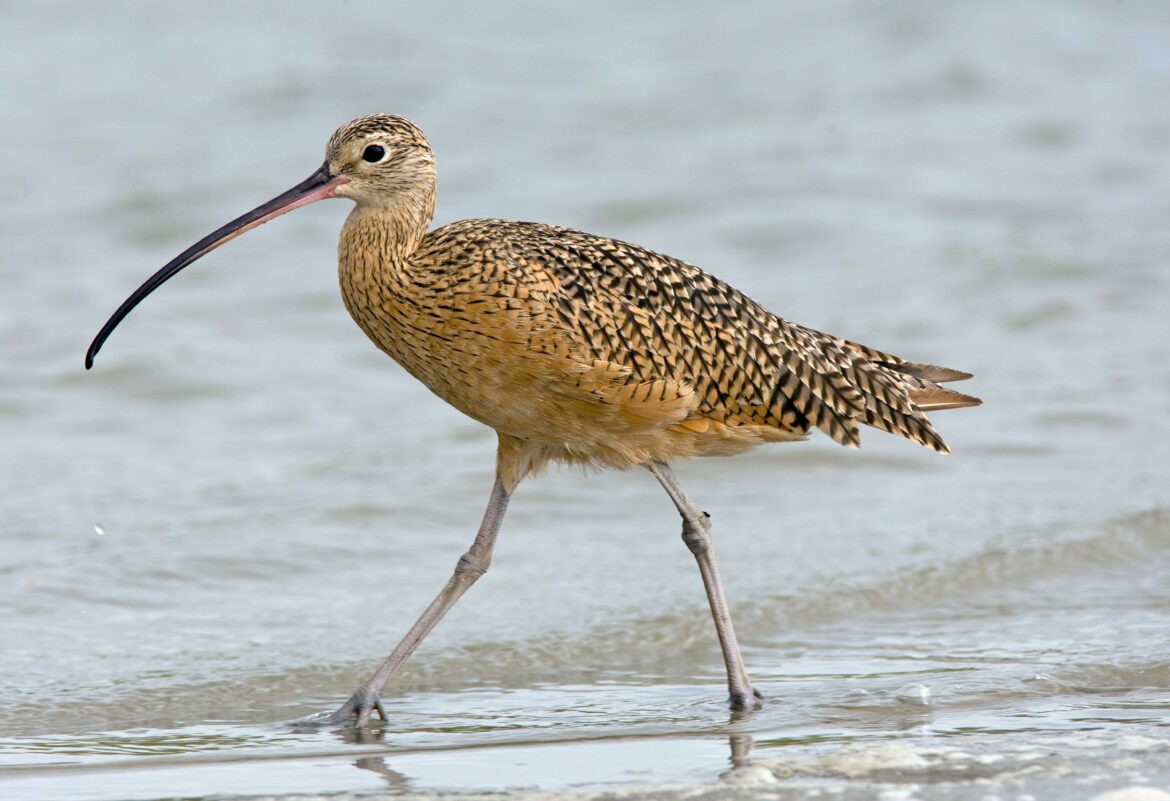By Ashley Casciotti
When looking at different types of shorebirds, one of the first things that may strike you is how different each of their beaks looks. Shorebirds have evolved different beak shapes and feeding behaviors that help them in their quest to find their dinner. Along the Texas coast, you can find many of these unique beak shapes and can watch the feeding behaviors that go along with them!
Probing is one of the most common feeding behaviors among shorebirds. This is when a bird tries to find food by poking its beak around in the mud. Once the touch receptors on the end of the bird’s beak feel a meal, they use their beak to snatch their prey. Since a lot of species of shorebirds use probing, there are many differences in how bird beaks look within this behavior.
The Long-billed Curlew, which spends its winters on the Texas coast is a good example of a probing bird. As the largest North American shorebird, they need plenty of food, and they find that food with their exceptionally long beak! With a beak as long as theirs, they can probe around holes for burrowing species such as crabs, shrimp, or worms. Other shorebirds like godwits and yellowlegs also use probing techniques, but their bills are not as long as the curlew, and they can’t forage as deep into the mud.
Chasing prey on the surface is another way that some shorebirds find food. Plovers, with their large eyes and short beaks, are fully equipped for this foraging method. When a plover sees its next meal, it will chase it down on foot and catch it. Although this seems simple enough, plovers have another trick up their sleeve! Sometimes when foraging, plovers will wiggle their foot in watery sand or mud, which brings worms up to the surface for them to munch on.
The plovers that reside in Texas usually feast on worms, insects, and other invertebrates. The Wilson’s Plover, which breeds on the Texas coast, eats almost exclusively crustaceans like crabs, and its beak is thicker than other plovers so they can crack open the exoskeletons to get to the juicy crab meat!
Another way that shorebirds forage is by sweeping their beaks back and forth in the water until they find a tasty insect, crustacean, or fish. They keep their beaks slightly open while doing this so that when they sense their next meal, they can snap their beak shut to catch their prey. This technique is called scything. Some Texas shorebirds that use this method are the American Avocet and the beautifully pink Roseate Spoonbill. Both of these birds have a very unique beak shape, with the American Avocet’s beak being upcurved and thin, and the Roseate Spoonbill having their signature spoon-shaped beak.
Sandpipers are also unique in the way that they feed because they eat what other birds won’t! Some sandpiper species have been found to eat biofilm, the layer of bacteria and other microscopic prey that accumulates on the surface of the shoreline. They even have microscopic spines on their tongues to help them collect the biofilm! Although they can be seen probing for larger prey as well, about half of a Western Sandpiper’s diet is biofilm. When you consider that they can consume half of their body weight in a day, it becomes apparent how important biofilm is to them.
It’s important to note that although the feeding behaviors mentioned in this article are the primary feeding behaviors of each of the species, reality is more complex. Most shorebird species will use a variety of techniques to get their next meal. It depends on the available food and the habitat that they are faced with.
There is more than meets the eye with shorebirds. I encourage you to keep an eye out for shorebirds next time you find yourself on a beach or wetland. They are worth the watch!
Photo: Long-billed Curlew by Mike Williams
Ashley Casciotti
Biology Intern
Gulf Coast Bird Observatory
Ashley Casciotti is interning at Gulf Coast Bird Observatory this summer. GCBO is a non-profit organization dedicated to saving the birds and their habitats along the entire Gulf Coast, and beyond into their Central and South America wintering grounds.

